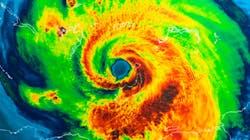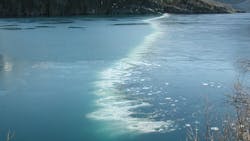For those of us living, working, and playing in South Florida, the Atlantic Hurricane Season (officially June 1 through November 30) is always a bit worrisome. This year, as of September 19, we had had 23 named storms, including two using the Greek alphabet for only the second time in history.
Of the 23 named storms, at press time, eight had become hurricanes, two of those (Laura and Teddy) becoming Category 3 or higher – characterized as having sustained wind speeds of 111 mph (96 kt) or higher – the definition of a major hurricane. When Beta made landfall in Texas, it was the ninth named storm to make landfall in the US this year, tying a record set in 1916.
Tropical cyclones, of any strength, are fueled by warm ocean water temperatures. Hurricanes are generally believed to require 80 deg. F. or warmer sea water temperatures to form or survive. Other widely accepted conditions for hurricane development, courtesy of the National Weather Service, are that hurricanes cannot form within 5 deg. lat. of the equator, due to the minimum Carioles force (caused by the spin of the earth); that they must have an unstable saturated adiabatic lapse rate (SALR) near the center of rotation in order for continued air rise and condensation to occur; that there be low wind shear in the upper levels of the atmosphere, since strong upper level winds prevent hurricane formation; that there is high relative humidity from the ocean surface upwards, since dry air inhibits deep convection, producing a stable SALR; and, that Atlantic hurricanes have a tropical wave, an atmospheric trough consisting of an elongated area of relatively low air pressure, oriented north to south, which moves from east to west across the tropics. These tropical waves frequently begin as thunderstorms off the coast of Africa.
Climate change, particularly rising sea water temperatures, are clearly causing more frequent and more intense hurricanes. Mitigating climate change by reducing greenhouse gas (GHG) emissions is, unfortunately, a long-term solution. So it seem likely that hurricanes will continue to cause death, suffering, and property damage for the foreseeable future, since the conditions that produce them are seemingly beyond our control… Until, perhaps, now.
A Norwegian startup, Ocean Therm, founded and led by Olav Hollingsaeter, may have a solution. After serving 38 years with the Norwegian Armed Forces and NATO, the retired submariner has developed Bubble Curtain, a perforated pipe lowered into the water. This pipe would be placed across, for example, a narrow strait, and would supply compressed air bubbles in the deep water. When those bubbles rise, they would bring the colder sea water to the surface, thus reducing the ocean surface temperature below 80 deg. F. The machinery would be similar to the bubblers used in marinas to prevent winter freezing, but on a much larger scale. So, during a hurricane season, ships would deploy these large Bubble Curtains.
The concept is not new. In 2009, Microsoft founder Bill Gates and geoengineering expert Ken Caldeira filed a patent application for a similar system, but apparently it never moved forward. In the case of the Ocean Therm system, a deep-water test has been conducted with SINTEF, one of Europe’s largest independent research organizations. In that pilot test, water from a depth of 50 meters (164 ft) was brought to the surface, where the water temperature was significantly reduced. SINTEF now is planning tests at depths of 150-200 meters.
Of course, the effort has its share of skeptics. Some do not think it is technically or economically feasible. Others warn of unintended consequences, such as causing a drought, if it actually does work. As an engineer and a Floridian who hates hurricanes, I say, "Keep on trying those out-of-box solutions!"
A regular contributor to HPAC Engineering and a member of its editorial advisory board since 2012, Larry Clark, LEED AP, O+M, is a principal at Sustainable Performance Solutions LLC, a south Florida-based engineering firm focusing on energy and sustainability. Email him at [email protected].
About the Author
Larry Clark
A member of HPAC Engineering’s Editorial Advisory Board, Lawrence (Larry) Clark, QCxP, GGP, LEED AP+, is principal of Sustainable Performance Solutions LLC, a South Florida-based engineering firm focused on energy and sustainability consulting. He has more than two dozen published articles on HVAC- and energy-related topics to his credit and frequently lectures on green-building best practices, central-energy-plant optimization, and demand-controlled ventilation.

